You’re listening to Burnt Toast! This is the podcast about anti-fat bias, diet culture, parenting and health. I’m Virginia Sole Smith.
Today I am chatting with Christine Yu, author of Up to Speed: The Groundbreaking Science of Women Athletes.
Christine is an award-winning journalist whose work focuses on the intersection of sports science and women athletes. Her writing has appeared in Outside, The Washington Post, Time, and other publications. And friends, her new book is fascinating! It is full of “holy shit” moments, like the fact that even though you’ve probably thought since middle school gym class that of course, men are the faster stronger athletes, women actually outperform men in ultra marathons and all the other bananas endurance events that are arguably the hardest physical challenges that human beings can undertake.
Christine also unpacks why sports science has ignored women’s bodies for so long and the very real harm this has caused. This is such an important episode if you are a woman who exercises in any capacity, or if you are parenting a child athlete. But even if neither of those categories apply to you, I promise this is such a good and fascinating and often enraging conversation.
For even more on protecting kids’ bodies in sports, don’t miss:
PS. If you’re enjoying the podcast, make sure you’re following us (it’s free!) in your podcast player! We’re on Apple Podcasts, Spotify, Stitcher, and Pocket Casts! And while you’re there, please leave us a rating or review. (We like 5 stars!)
If you order Up to Speed from the Burnt Toast Bookshop, you can get 10 percent off that purchase if you also order (or have already ordered!) Fat Talk! (Just use the code FATTALK at checkout.)

Episode 114 Transcript
Christine
I’m a journalist and I cover sports and science and health. And I’m the author of the book Up to Speed: The Groundbreaking Science of Women Athletes, which just came out in May. I live in Brooklyn with my husband and two kids. I tend to report on women’s sports and sports science and this intersection of the two of them. It has been lots of fun.
Virginia
And we are here to talk about the new book, which is so smart. It’s so impeccably researched. As I was reading it, I just kept thinking, holy shit, holy shit. Like, why don’t people know this? Why is this not more widely known? So, thank you. It is a real gift of a book.
Christine
Thank you! Your “what the heck?” reaction was, frankly, what I felt when I actually started to think about this a little bit more. As someone who reports on science and health all the time, you read all these studies but you have these short deadlines, and you’re just like, “I need studies to look at and read.” It made me feel like I wasn’t doing my job. Like, how could I miss or not even think about the implications of all this? I felt like my personal guilt went into this a lot.
Virginia
I relate. I did a lot of fitness reporting in my women’s magazines days. And we were just accepting some really limited science as fact and running with premises that were not borne out by the research.
Christine
On the one hand, we have been hearing so much about how medical research doesn’t include women. But as someone who grew up playing sports and is still fairly active, I’m really trying to understand what that means for girls and women in the long term. How does that affect, sure, athletic performance — but really long-term athletic development, health, wellbeing? Because what I was uncovering were all of these issues that we don’t talk about, we don’t really understand, and we don’t communicate to girls and women about. And yet they have long-term health repercussions on bone health, on cardiovascular health, on everything.

Virginia
Mental health..
Christine
Yes! And we don’t communicate that. And knowing that sports is such a growing part of a lot of people’s lives, or just physical activity, and we tout that so much. So I was really trying to understand what are we missing here because we don’t study women?
Virginia
I want to get more into some of those specific implications you touched on, but before we get too deep into all of this, I do want to quickly address the question of gender inclusive language. You talked about it at the top of the book and I just thought, for our audience, it would be helpful here. You were really focused on the way science has underserved the biology of people assigned female at birth, but then also in the broader cultural dismissal of women athletes, regardless of biology.
Christine
Yeah, it’s really tricky, especially because both sports and science are two fields that are so predicated on the sex and gender binary, right? In science, we have male specimens, female specimens, and they’re very separate things. And similarly, in sports, we have those two categories.
So when we’re thinking about not only women athletes, but thinking about trans athletes and nonbinary athletes, how can we talk about this in a way that isn’t excluding folks, but really trying to find language that was more inclusive? Because when you think about sports and when you think about science, it very much prioritizes male bodies and cis het men. So how we can talk about this in a more inclusive way, because when we just focus on those cis het men and male bodies, we do exclude not just female people living in female bodies, but we do exclude all these other folks that are marginalized by sex and gender.
Virginia
One really big consequence of not studying people assigned female at birth, ever, for all of science, is this absurd misconception that too much exercise will damage a female body. Like, literally, people believing that your uterus will fall out. I had Martinus Evans, 300 pounds and running, on the podcast a few months ago. And we were kind of joking about how that had been a barrier to women joining the marathon, but it’s completely true. It was what happened! Talk us through that one a little.
Christine
It’s wild because this is an idea that has existed since forever, right? Since the time of the ancient Greeks and the Romans, people have thought it wasn’t appropriate for women to enter into the athletic arena. And in the cases where women were allowed to compete, the distances of races were shortened. Because of our fragile bodies.
But for me, it highlighted this idea that women’s roles were centered around our reproductive capacity, our ability to bear children and carry children. That was so central to everything, that anything that could potentially damage that capacity was considered off limits. We can’t do that. And that just became an idea that was never really interrogated. Or actually, that’s a lie. It was interrogated and it was interrogated mostly by women scientists and doctors in the 18th century. They were looking at this and doing studies and saying, “No, we’re fine actually.”
Virginia
“We’re doing great.”
Christine
Actually, this doesn’t affect menstrual cycles. This doesn’t affect reproductive capacity. Uteruses are intact, ovaries haven’t burst. But those women weren’t taken seriously, even though they were actually doing scientific studies. The men in power and the men who were leading all of these efforts were like, yeah, that’s great. We’re still not going to listen to you.
Virginia
“You’re biased by being a woman. You couldn’t do this objective science on your own body.”
Christine
Exactly.
Virginia
I will say, I did love the reference you made to one early scientist who did advise that noblewomen could exercise by yelling at their servants. So problematic. Clearly so problematic in so many ways we could unpack. Also, I mean, I do kind of love yelling? Is that my new workout?
Christine
This was a Spanish doctor. He had put out one of these first books on exercise and there was a specific chapter looking at exercise for women. But a lot of these observations came from his travels from Europe to Mexico. He had stopped, I believe, in the islands, maybe like Cuba or something like that. And he was observing the nuns there. And they were like, super healthy, right? Mainly because they were not reproducing and dying in childbirth.
Virginia
Not risking their lives to have babies every two years.
Christine
But they were singing, right? So he believed that that was conducive to their health.
Virginia
And all the exercise you need.
Christine
It was interesting. He also separated it out by class, right? For upper class women it was “walk around after dinner and yell at your servants,” and for women of lower class, because they’re working in the fields, working in the house, it was “that’s enough exercise.”
Virginia
No yelling from you, lower classes.
Christine
Oh, no, no, no, no.
Virginia
We don’t need to hear your voices. Only one kind of yelling and no women yelling at men.
Christine
No, no, no.
Virginia
Yes. Like I said, really problematic. But also, I could get on board with the yelling. I could see a yelling workout being a big trend.
Christine
Can you imagine? It totally would be.
Virginia
I would go to that group fitness class is all I’m saying.
So, on the one hand, you’re absolutely right, the conventional thinking has been “we have to protect fertility and the woman’s body is so fragile, and the uterus is made of glass and we have to revere it.” And then on the flip side, as women do enter sports in a bigger way, there becomes this new narrative and this really dangerous misconception that exercising to the point that you no longer get your period is okay, normal, maybe even the goal of the whole thing.
Christine
It’s this contradiction, right? In the sense that it’s almost as if, if women were going to participate in sports, we had to make our bodies more like men. And I feel like that’s where a lot of this myth and misconception around losing your menstrual cycle being a good thing, being a sign that you are really fit and are training really well, I feel like that’s where that comes from. This idea that if we are entering into this arena and are deemed appropriate to enter into this arena, we almost have to shed all of these markers of being in a in a female body. Like losing your menstrual cycle, generally having smaller boobs, too, probably. There’s less stuff bouncing around and distracting and all of that stuff. Having this super lean body for a lot of sports, as well. I think there are a lot of really problematic things that go along with that.
Virginia
And the menstruation myth is especially problematic for teen athletes, obviously, because of how it can delay the onset and really mess with the puberty trajectory. What do you want parents and girls to understand about athletic performance during like the tween and teen years?
Christine
It’s so hard, right? There’s so much change that’s going on, and it’s so awkward. And but when you think about it, the amount of change that that kids are going through at this period of time, right? It’s like akin to when they’re babies.
And it’s so alluring, especially if you have a girl who is playing sports and seems to be doing well. We see this a lot in sports like cross country running, that younger girls perform really well. They run really fast. And then older girls, once they do start to go through puberty, their performance seems to drop off. So the idea is, “Well if I just don’t go through puberty, then I can keep being fast.” But this is what our bodies need to do. We need to go through puberty. We need to go through this maturation process in order to get to our adult form.
It’s really important that they understand and know that this is critical. This is a critical piece of development. It’s not just about fertility, right? This ties back to how we learn about, about our bodies as girls is we only learn about it in terms of reproduction and fertility and how to not get pregnant and that type of thing. But we don’t understand the intricate things that our menstrual cycle does in our body and all those hormones that are involved in it, and the impacts that it has throughout the body and all these other systems and ways.
As parents, it’s knowing it’s a hard line. Anything is going on with your period, that’s the hard line.
Virginia
We’re not going to risk your future bone health.
Christine
Yeah, exactly. I feel like that that’s a really important message that parents need to know and understand that it’s not normal.
Virginia
I think they need to know to push back because I think there has been a change in conversation. Your book is a really big contribution to that. But I think you are likely to still encounter coaches—in certain sports, in running or gymnastics—where they’re going to have this mindset of keeping you as small as possible is good. Parents need to know to push back against that.
Christine
1,000 percent. It’s also understanding that, because the body changes so much during this period of time, of course there’s going to be this period of transition as girls get used to their new bodies. So it makes sense, if we just think about athletic progression, maybe their athletic progression does stall or like seems to go backwards. But that’s not the end of the world. Just understanding this as a period of transition, that we do have to acknowledge, we do have to be supportive of, and patient with. But then once you get through to that other side, things get better.
Virginia
That seems like such an important reframing because you talk in the book about how for folks assigned male at birth, the puberty process is like more of a straight line towards athletic performance. Like, you gain more muscle, you get taller and bigger and faster. And we need to understand that not all bodies are going to follow that trajectory. Because why did we decide that the male trajectory is the best trajectory for a body?
Christine
Yeah, I think it’s largely because that’s all we’ve known. Boys and men have largely been the ones participating in sports. Those are the ones we’ve studied, those are the ones that we’ve mythologized, in a way. That’s the trajectory that we tend to look at. We see a standard, so we just compare girls and women to that same standard. I think it’s also just our bias to want to see progression inch up in this very linear way, right? We’re constantly just slightly improving. But not recognizing that we’re humans. We are not an algebraic equation, right? There are going to be dips. And that’s part of being a human.
Virginia
I mean, that really gets to a whole paradigm shift in terms of sports culture, right? I mean, if it’s always about winning, if it’s always about the next championship, if it’s about working towards that college scholarship—None of that allows for this idea that there’s going to be a few years where your performance dips but it’s all part of your overall growth.
Christine
I think we’ve lost sight of that a lot in sports, over the years. I mean, definitely within the youth sports culture. I know you write about this as well, but just that emphasis on early specialization and success and winning and this focus on getting college scholarships and going pro, and all of our kids are going to be the next great Olympian superstar.
But especially in childhood and adolescence, we lose sight of sports being just this amazing developmental tool and space to experiment and perform and not only get to know your own body, but develop your skills, right? Your understanding of who you are and what you’re capable of in a way that is within a specific sphere that you can you can practice and experiment in a way that I don’t think you can in a lot of other ways. We lose sight of that when we just focus on this end goal of being the best.
Virginia
It does seem like there’s a little bit of a shift happening. You have a lot of great stories in the book and I feel like the way someone like Simone Biles or Abby Wambach has talked about their athletic careers, I think we’re starting to see this narrative of it’s not always just excellence, excellence, excellence. It can be more complicated and that there are also many opportunities for growth. It also feels like it’s no accident that we’re hearing that narrative mostly from women athletes, that they’re the ones speaking up about that.
Christine
Absolutely. Because it’s vulnerable to right to be able to show this other side and to at least acknowledge that there are these down points and these lulls and these deep trenches when you are trying to work your crap out, right? Trying to figure out how to work through this and keep going.
Virginia
I also want to spend some time on your very excellent chapter about diet and sports. This was so well done. It feels like nutritional science, athletic research— all of this research—has only just recently given women permission to eat as athletes, and to eat enough to support their sports. This feels really staggering to me, that there has been this underfeeding of women athletes for so long.
Christine
Consistently. All the time. And I think it’s in part because of just general diet culture in our culture and society and these ridiculous expectations that we have or we place on girls and women in terms of what their bodies need to look like. And then you have the sports performance side, you have this idea that certain body types are the ideal athletic body types.
It’s almost no wonder that we create this perfect storm and a way for disordered eating and eating disorders and all these other problematic behaviors to take root. Especially because bodies are so central, obviously, in sports and performance. And we focus so much on bodies and how they look, what their body composition is, and all of these different things, the shape of you, all of that.
It’s wild to me that it’s only been recently that we do acknowledge the fact you just need to eat. We talked so much about nutrition and sports as this idea of fueling your body, which I think was at first kind of helpful in the way of reframing food within this context. Your body needs fuel to be able to do all this stuff, in order to start to give folks a little bit more permission to eat or feel like they could eat what they needed. But that, I think, even still creates this idea that there’s a certain kind of fuel that you need to be eating in order to be an athlete, in order to fuel your body correctly, if that makes sense.
Virginia
It’s, again, mind blowing, but makes sense that we had to first embrace the idea of eating, period, as opposed to eating being the enemy. You have so many heartbreaking stories from athletes in this chapter talking about feeling like they were so tapped out at the end of a practice that they couldn’t function and that when they started eating enough, they were like, wow.
Christine
Turns out!
Virginia
“I can do a 90 minute workout without a problem!” The fact that they were performing at all when they were being asked to do it while starving is ridiculous. It’s ridiculous what they were being asked to do. Then seeing that immediate and logical shift that if you feed yourself, you can perform better. But then from there, this idea of food as fuel can also become very limiting because, of course, athletes are human beings, as well. And food is more than fuel for all of us.
Christine
It’s really easy within sports and athletics to look at food as almost a hack, in a way. Like, as a way to like fine tune your performance. Oh, I need more iron, or whatever other very specific thing that you need. And again, I think it dissociates food from what it actually is. I think that also just makes it really ripe to encourage a lot of these behaviors that aren’t always helpful or healthy.
Virginia
You also do some amazing work in this chapter dissecting a couple of the modern big diet trends: Intermittent fasting, keto, and you even look at some of the less extreme ones like the Mediterranean diet, and show how they underserve athletes and especially women athletes. I wondered if we could just spend a little time talking about your findings there, because that felt super important to me.
Christine
In the last several years, we’ve seen things like intermittent fasting and keto pop up within athletic communities as this way to make your body a better machine. Especially, I think, within endurance sports, it’s this idea that your body can run longer or you can somehow create these these efficiencies, if you will.
But the body likes to be in homeostasis, it likes to be in balance. So anytime energy levels start to dip, your body starts to send out these flares that are like, “Wait a second, hold on. Are we going to be starving real soon?” Because if so, I need to make some adjustments, physiologically. So with a lot of these diets, you’re actually ended up with these long periods of under-fueling your body. With intermittent fasting, you’re not eating for anywhere between eight to many, many hours. So you’re leaving your body in this huge deficit of energy so it starts to freak out and starts to shut down these non essential systems.
And the thing with women is that our bodies are much more sensitive to these downturns in nutrition. It starts to send up those flares a lot earlier, it starts to make those those physiological changes a lot earlier. That can have repercussions on things like your menstrual cycle and all the hormonal things that your body does.
Similarly, with keto, this whole idea of eating a lot of fat and very few carbs might seem like, Oh, I’m really full, I don’t need to eat as much. But it’s the same idea that you end up inadvertently underfueling your body. But more importantly, especially for women, by not eating carbs, it sends up those same flares to the body. Women’s bodies, in particular, need carbohydrates in order to function well, in order to do all the things it does. And when we don’t have carbs, the body starts to send all these warning signs.
We tend to see intermittent fasting or keto “work” in men because it seems like male bodies can get away with that under-fueling a little bit more than female bodies. But when women tend to try these diets they end up feeling, unsurprisingly, really flat, really fatigued, a lot of brain fog. They don’t see this performance boost and then they wonder what they’re doing wrong because all the podcasts, all the influencers, say I should be intermittent fasting. This is going to be how I’m going to lose weight. This is how I’m going to cut time on my race. This is how I’m going to improve performance, improve body composition, all the stuff. But I’m not seeing that. I’m feeling flat. I’m not seeing all these other positive benefits. It’s because your body is essentially saying, ah, this isn’t working for me.
Virginia
Just because it works for Peter Attia does not mean—and question mark on if it even works for these guys? Thats the other thing I just want to interject. It might improve athletic performance, it doesn’t mean it’s not having other consequences on their mental health or their relationships with food and body. But that’s fascinating to realize specifically, if your goal is improving athletic performance—one of these diets is not going to deliver for you the way you’ve been told it might.
Christine
Especially the idea around carbs. I feel like carbs still have like a bad rap. People are still really afraid to eat carbs and I just want folks to know it’s not a bad thing. Your body actually needs it. It wants them.
Virginia
The stories of these athletes who are living with these diets and the way they’re struggling, it just sounds miserable.
Christine
Miserable. Well, and the sustainability of it too, just sounds horrible.
Virginia
Okay, we also have to talk about sports bras. I wear a 38 G. Christine, why are all sports bras so bad? What’s going on?
Christine
They’re terrible. I will say, I didn’t really think a ton about this because I’m small-chested. Sure, I dealt with the crappy Champion sports bras and taking them off sweaty, and all this stuff.
Virginia
Getting trapped in it.
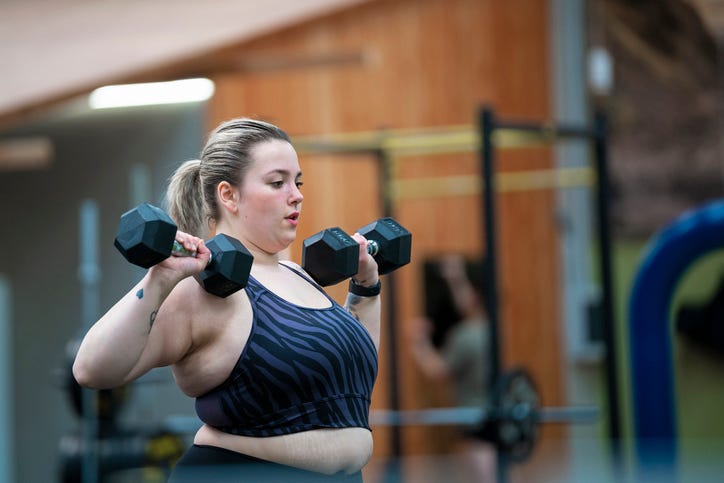
Christine
Feeling like I’m going to dislocate my shoulder. But I never really thought about it so much.
But I think it’s in part that the sports bra wasn’t designed or invented until 1977, which is like, less than 50 years ago, which is totally absurd! These women sewed together two jockstraps and were like, wait a second, we have something here. But also because breasts were never really taken seriously. Because again, I feel like it’s this female body part associated with female bodies. So why do we need to study that? It’s largely associated with either nursing or sex, right? It’s very sexualized.
We just have this dismissive view of breasts as, they just move up or down. Like, why do we need to study them? Like, what does that have to do with athletic performance? But as anyone who has breasts knows, they have a lot to do with how we feel in our bodies. When we move and we’re more physically active, it can be painful. It can actually change your running gait, so that you pull your arms in closer so you’re not bouncing around so much. You might shorten your stride. It has all of these repercussions, but we’ve never actually really studied it a lot.
It really wasn’t until the 2000s and 2010s, that scientists actually got the technology to be able to study breast biomechanics in a lab. Before that, the sensors that they had were really big and bulky, like they couldn’t put it underneath the bra. All of these things that made it really hard,
Virginia
It’s not going to help someone run with a bra if you’re putting big sensors on them as well.
Christine
Exactly. And it’s dragging down, so you’re not capturing the movements accurately. But if you don’t study the movement, you can’t know what’s going on, you can’t actually design a garment that can accurately or effectively support and control that movement in a way that is comfortable. So I think that’s in part why it’s taken so long.
I think sports bras are getting better. They’re not perfect by any means. But at least brands and companies are now starting to include this type of research in the research and design process and their product design process, so that they can really understand what’s going on. And wear testing them on a lot more people and people of different sizes, right? Because a lot of times it has always been a very traditional straight-size, thin, lean women who are trying this stuff out. But now we’re seeing that they’re they’re starting to expand that as well.
Virginia
It is just a fundamental barrier. I don’t think about running as a sport I feel like exploring for many reasons. I had a disordered relationship with it. But reason number two is that figuring out a sports bra is an exhausting process.
I’ve figured out what works for lower impact, like strength training, yoga, even a HIIT class. I have bras that can work for that. I mean, it’s always that trade off of if it provides enough support, you’re straitjacketed into it and it’s super uncomfortable. And yeah, that sweet spot of comfort and support is is still a unicorn in the larger sizes, especially.
Christine
Well, and then a lot of the women I spoke with, not all of them were included in the book, but just there are so many stories from women who felt like they lost out on something when they were younger because they didn’t have a sports bra that that was comfortable and supportive of them. They lost a piece of their athletic lives because of not having this garment. It is so essential that we don’t think about it. When we think about the number of girls that also drop out of a sport, during adolescence, I feel like this is a big piece of it, too. Whether it’s access to sports bras, just the money of it, or just not finding one that that fits well.
Virginia
Because the ones that do work are quite expensive. And if you’re a parent that includes for a kid who might outgrow it in six months, to spend $70 on a sports bra is going to be a real barrier for folks. It’s a fascinating history.
You talked about Lululemon improving the technology. They are not fully size inclusive, but for smaller folks, it sounds like one to explore. And Bloom bras I think is the other brand you mentioned that is doing more size inclusivity.
There’s so much in the book, we could talk about it for hours. Is there anything we haven’t hit on that you feel like is a really important aspect of this whole conversation?
Christine
Yeah, I think that we also see this a lot as women age, into what I’m calling mature adulthood. You know, I guess, I’m officially late 40s.
When we think about the menopause transition, and I know menopause is like the hot topic now. But in similar ways, it’s literally this black hole of information and research, in which women were just left to kind of figure it out themselves, right? It’s like, oh, that sucks. Or, Oh, you’re not fertile anymore so why do we need to pay attention to you? Like, who cares that you’re still going to spend a good chunk of your life in this period of time. Who cares that you suffer these tremendously debilitating symptoms that affect quality of life, mental health, and all of these things? Good luck.
Virginia
Have fun with this new body that is confusing and impacting the things you love to do in ways that we can’t explain.
Christine
I think especially for women who have been active or have been athletes. I’m not even talking about any sort of professional or competitive level. But even for someone like myself, being physically active has been a big part of my life and my identity. And it’s really disorienting coming into this period of time right now, when your body is shifting and changing in so many ways. You feel like you have no resources or no idea or recourse, frankly, of what to do.
This is a period of time where it’s just, it’s hard. I think people are starting to pay more attention to it and we’re trying to figure out some of the stuff, but I also worry at the same time because it also feels very ripe for the whole diet culture thing, where we’re selling supplements and diets and serums and all this other stuff for women to use to fit into this traditional idea of what we should look like and should be like.
Virginia
Well, this is what we see over and over when science doesn’t include women, when mainstream medicine doesn’t include women. What fills the gap is diet culture. You’re left out of the mainstream work on this and yet you’re still struggling with the things you’re struggling with. And so who is there for you? Someone with a bunch of weird supplements, someone with a cool restrictive diet plan, some celebrity claiming this solved her hot flashes. It makes total sense that we are vulnerable.
Christine
Yeah, no, it absolutely makes sense that these things are cropping up because I think a lot of us are just really hungry for information and some sort of guidance as to what in the world is going on?
The message that I hope that the book helps to get across, too, is this idea that we haven’t really been taught about our bodies or encouraged to really become body literate. What I hope is just encouraging folks to pay more attention to yourself and what’s going on in your body. Like tuning into that and understanding that, right? You don’t necessarily need like a cycle syncing plan for your workouts. But you do need to kind of understand what is my experience through my menstrual cycle, at these different phases? Because maybe that does explain how I feel so I’m not constantly blaming myself for feeling lazy or flat, or not able to complete my workout. Maybe it is because every third week of my cycle, I feel like this, so maybe it is my hormones. But just understanding that because this is our physiology. If you are in a female body, this is part of the physiology1 and we need to appreciate that and understand that in the same way that we may think about nutrition and we may think about cardiovascular fitness and all of these other aspects.
Virginia
The thing I kept thinking as I was reading the book was how much we have defined our bodies according to this standard that simply does not apply.
And it is, as we were talking about, this standard related to male bodies, the male body trajectory, this whole culture of success and what success looks like and that it’s always linear and straightforward.
You just think of the the guilt that people feel when they skip workouts or the way you feel like, “oh, but if I didn’t work out for 45 minutes, it doesn’t count.” If it was only 20 minutes, that’s not good enough or my pace was slow so this was a bad workout. Like all the ways we punish ourselves for not matching up to this all or nothing mentality. When it’s clear that the science we do have is showing that that does not serve our bodies in any way. So, I appreciate you. You’re walking us through that and making that so clear and so evidence based. It’s really helpful.
Christine
Yeah, no, it was really a lot for me just trying to understand like, well, who is making the rules, right? And do we need to listen to them? And understanding those underlying systems that prop all of this up. Because, again, like I was saying in the beginning, I didn’t really think about this as a journalist. I didn’t really think about all these blind spots that have been just built into the system and that we just take for granted and do not question. My hope is that we start to take just a little bit more of a critical eye to some of these issues.
Virginia
Yeah, it’s so important. And the book is so empowering. So thank you for putting it out there. It’s really great.
Butter
Virginia
Christine, what is your butter today?
Christine
I actually have two.
Virginia
Oh, great. We have a lot of butter.
Christine
My first one is afternoon naps. Huge proponent of afternoon naps. A perk of working from home, but afternoon naps have just been really life giving lately.
Virginia
That’s awesome.
Christine
Then the other one is I went to a conference over the summer and one of the things in the goodie bag was a sweatshirt that they gave us and it was a Champion sweatshirt but since it was summer I never got a chance to wear it. And so now since the weather is starting to get a little cooler here in New York I am wearing this Champion sweatshirt with a nice fuzzy inside, like the brand new sweatshirt fuzzy. It’s fantastic. I’ve probably worn it for way too long without washing it because I don’t want the fuzz to go away.
Virginia
New sweatshirt fuzz is a specific feeling and it does wear out after you start washing. New sweatshirt fuzz is a great butter. And a nap in your cozy sweatshirt. I’m loving that whole afternoon for you!
My butter is a book that I’m almost finished in listening to as an audio book. It’s kind of an old recommendation because I think it made a splash a few years ago, but if you guys haven’t read When Women Were Dragons by Kelly Barnhill, it is fantastic. I don’t know what the genre is called… feminist sci fi? It’s kind of like A Handmaid’s Tale meets Lessons in Chemistry plus dragons.
It’s set in the 1950s and the premise is that these women transform into dragons at critical junctures in their lives and often in response to bullshit from the patriarchy. And it tells the story of this one family in particular, and how they have tried to cover it up.
It actually intersects really nicely with your book because there are a lot of moments where the main character is someone who’s like really great at math and science and trying to pursue that. And yet, in the 1950s, and in the world of this book, it’s just not at all allowed for girls to do it. People keep saying to her, “but you’ll make the boys feel bad, how do you think the boys feel when you’re getting such good grades, and you don’t even seem to be working that hard, and you’re top of the class.” And so they’re making her help and tutor the boys who are struggling because she’s good at it, but they don’t want the boys to feel bad. And I just thought I think similar things happened in sports for a long time.
Christine
That sounds fascinating.
Virginia
It’s a really fun read.
Well, Christine, this was great. Thank you so much for being here. Why don’t you just tell listeners where we can follow you and how we can support your work.
Christine
You can find me on Instagram and my website. And from there, the links to all the other things and newsletter and all of that stuff.
Virginia
Perfect. We will link to all of that in the show notes. Thanks so much for being here!
The Burnt Toast Podcast is produced and hosted by me, Virginia Sole-Smith. You can follow me on Instagram.
Burnt Toast transcripts and essays are edited and formatted by
who runs @SellTradePlus, an Instagram account where you can buy and sell plus size clothing.The Burnt Toast logo is by Deanna Lowe.
Our theme music is by Jeff Bailey and Chris Maxwell.
Tommy Harron is our audio engineer.
Thanks for listening and for supporting anti-diet, body liberation journalism!
Just a reminder and acknowledgment that not existing in a female body and not having these cycles is also totally normal and fine.


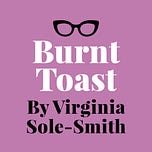



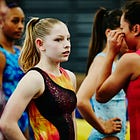
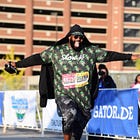


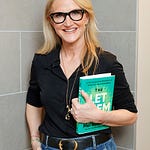







Share this post